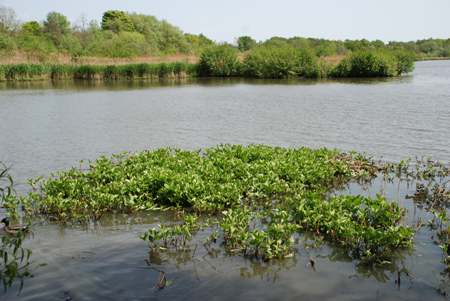
Michelle Salter writes:
The pretty, white flowers of Bogbean have been appearing along the edges of the reedbeds at Hemelite Bay. Bogbean is a creeping aquatic perennial that grows along the sides of lakes, ponds or slow-flowing rivers. Often forming large colonies, Bogbean plants help to protect the greenery of the reedbeds against damage from Canada Geese.

The flower buds of Bogbean are rose-pink and open up into feathery white stars as the petals are fringed with white threads. The plant has distinctive three-lobed shiny leaves raised on long stalks to avoid shade. The leaves of Bogbean have been used to flavour beer, giving the plant the alternative name of ‘bog hop’.

Garlic Mustard, also known as Jack-by-the-Hedge, because of the long lines of white flowers that form alongside hedges in spring, is currently in flower and can be seen at the side of the footpath by the railway.
When crushed, the leaves have a distinct smell of garlic, and the flowers attract a large number of moths and butterflies, including the colourful Orange-tip.

The dreaded Skunk Cabbage, Lysichiton americanus, has been popping up all around the pond’s margins, originating from the large patch that grows just over the fence by Brookly Bridge. This patch of Skunk Cabbage marks the remains of what was once a private garden that housed other exotic imports, such as bamboo, which can be seen growing vigorously along the stream’s banks.
Skunk Cabbage is thought to have been introduced to this country from North America in 1901. A marginal aquatic perennial that grows in boggy areas and shallows, the plant seeds freely and will soon spread the full length of a stream and beyond. Sizeable clumps are now appearing all around the pond; these can cause problems as they shade out other vegetation.
Skunk Cabbage is so named because of the strong, musky scent the flowers produce to attract pollinating insects in spring. Its huge green leaves can grow up to a metre tall. The striking yellow flowers that recently appeared are now being followed by knobbly seed heads.

For a pleasanter fragrance, try walking along the banks at Sandhills where there are still some lovely displays of bluebells.
Next month: Watch out for the tall flowers of Yellow Flag iris which are already starting to appear around the pond.
Picture credits: Michelle Salter

2 thoughts on “May Wildflower Watch – Bogbean, Garlic Mustard and Skunk Cabbage”